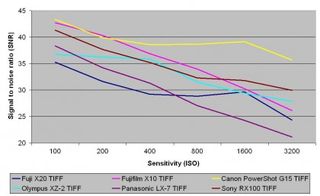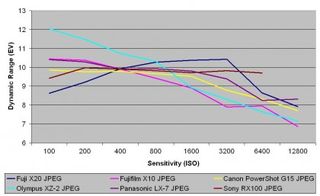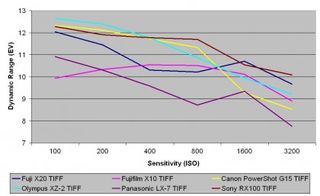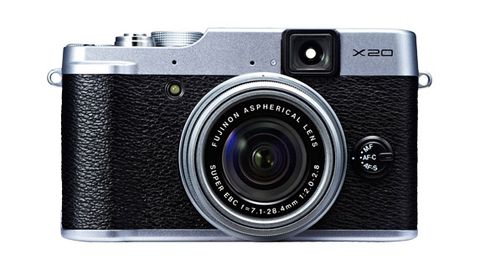Why you can trust TechRadar
We shoot a specially designed chart in carefully controlled conditions and the resulting images are analysed using DXO Analyzer software to generate the data to produce the graphs below.
A high signal to noise ratio (SNR) indicates a cleaner and better quality image.
For more more details on how to interpret our test data, check out our full explanation of our noise and dynamic range tests.
Here we compare the Fuji X20 with the Fuji X10, Olympus XZ-2, Panasonic LX7, Canon G15 and Sony RX100.
JPEG signal to noise ratio

These results show that JPEG images from the Fuji X20 contain relatively strong signal to noise ratios, beating JPEGs from the Fuji X10 at every sensitivity but ISO 6400 - where the two cameras tie - and 12800, where the older X10's images are stronger. The X20's JPEGs have greater signal to noise ratios than those from the Olympus XZ-2 at every sensitivity, the Panasonic LX7 at every sensitivity but ISO 12800 and the Canon G15 at every sensitivity but ISO 1600. The Fuji X20's JPEG images show greater signal to noise ratios than those from the Sony RX100 at ISO 100 and 200, score the same at ISO 400 and are weaker at ISO 800 and above.
Raw signal to noise ratio

As this chart indicates, the signal to noise ratios of the Fuji X20's TIFF images (after conversion from raw) are weaker than those from the Fuji X10 at every sensitivity setting, with an especially significant difference at lower ISOs. The Fuji X20's TIFFs also show weaker signal to noise ratios than TIFFs from the Canon G15 and Sony RX100 at every sensitivity setting, and are weaker than the Olympus XZ-2 at every sensitivity but ISO 1600. The X20's TIFFs are weaker for signal to noise ratios than the Panasonic LX7's at ISO 100-400, but at ISO 800-3200 the X20's images take the lead there.
JPEG dynamic range

JPEGs from the Fuji X20 contain less dynamic range than JPEGs from the Fuji X10 at ISO 100 and 200, the same amount at ISO 400, and more dynamic range at ISO 800 and above. Oddly, it's the exact same story with the Canon G15, and a similar story with the Panasonic LX7 and Sony RX100, except that then the Panasonic's JPEGs overtake the Fuji X20's at ISO 12800, and the Sony's JPEGs show greater dynamic range than the Fuji X20's at ISO 6400. The Fuji X20's JPEGs contain less dynamic range than theOlympus XZ-2's at ISO 100-400, the same amount at ISO 800 and more dynamic range at ISO 1600 and above.
Raw dynamic range

This chart indicates that TIFF images (after conversion from raw) from the Fuji X20 contain greater dynamic range than those from the Fuji X10 at every sensitivity setting but ISO 400 and 800, and greater dynamic range than those from the Panasonic LX7 at every sensitivity. The Fuji X20's TIFFs show a weaker dynamic range than the Olympus XZ-2 and Canon G15's TIFFs at lower sensitivities, but the X20's images overtake theirs at ISO 1600 and 3200. The Sony RX100's TIFFs have greater dynamic range than the Fuji X20's at every sensitivity setting but ISO 1600.
Current page: Noise and dynamic range
Prev Page Image quality and resolution Next Page Sample images
